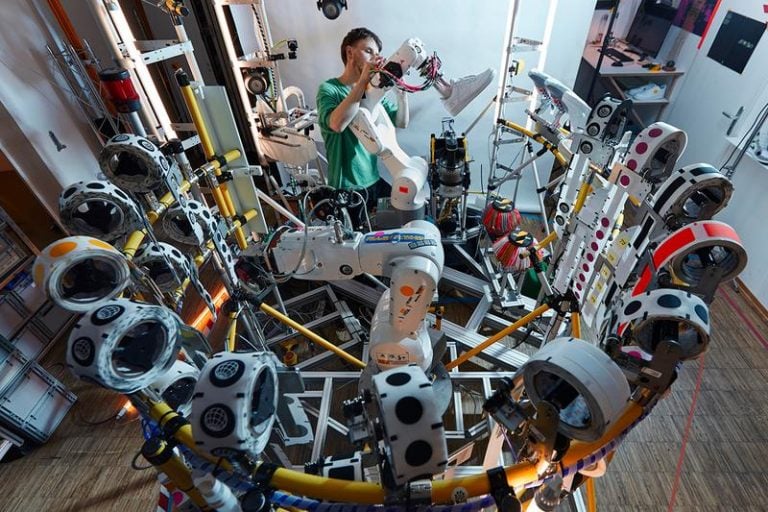Why Nike Shoe Production Remains A Challenge For Robots

Table of Contents
The Dexterity Dilemma: Handling Diverse Materials and Complex Assembly
The creation of a Nike shoe involves a surprisingly complex interplay of materials and processes. This complexity presents a significant hurdle for robots, highlighting the limitations of current automation technology in this specific manufacturing sector.
The Nuances of Material Manipulation
- Different materials require varying handling techniques: Nike shoes utilize a wide array of materials, including leather, mesh, synthetic fabrics, and various foams. Each material possesses unique properties that affect how it should be handled during the manufacturing process. Robots struggle with the flexibility required to precisely manipulate these materials without causing damage.
- Adapting to different material thicknesses and textures: The varying thicknesses and textures of these materials further complicate the process. A robot needs the sensitivity to adjust its grip and pressure accordingly, a capability that remains a challenge for current robotic systems. Precise glue application and consistent stitching remain particularly difficult tasks for robots.
- Limitations of current robotic grippers: Current robotic grippers lack the dexterity and sensitivity of a human hand. They often struggle to grasp and manipulate delicate materials without tearing or damaging them. This necessitates the development of more sophisticated grippers with improved tactile feedback.
- The promise of soft robotics: Research into soft robotics offers a potential solution. Soft robotic grippers, inspired by the flexibility and adaptability of human hands, could offer a more gentle and precise way to handle the diverse materials used in shoe production.
The Complexity of Shoe Assembly
- Numerous intricate steps: Assembling a shoe involves many intricate steps, including attaching the uppers, molding the midsoles, assembling insoles, and securing laces. Each step requires a high degree of precision and dexterity that is currently beyond the capabilities of most robots.
- Precision and dexterity challenges: The precision required to align components and apply the correct amount of pressure during assembly is substantial. Current robots often lack the fine motor control and spatial awareness necessary to execute these tasks consistently and accurately.
- Variation in shoe designs: Nike produces a vast array of shoe designs, each with unique construction methods. This variation poses an enormous challenge for automation, requiring robots to be reprogrammed and recalibrated for each new design.
- Challenges in coordinating multiple robotic arms: Assembling a shoe typically requires the coordinated actions of multiple robotic arms. The challenge lies in programming these arms to work together seamlessly and precisely, avoiding collisions and ensuring the smooth flow of the assembly process. This coordination requires advanced AI and machine learning capabilities that are still under development.
The Cost Factor: Investment vs. Return on Investment
Automating Nike shoe production is not simply a matter of buying robots and plugging them into the existing manufacturing line. The financial implications are substantial and require careful consideration.
High Initial Investment Costs
- Expensive robotic systems: Developing and implementing robotic systems for shoe production involves significant upfront costs. The cost of specialized robots, programming software, integration with existing infrastructure, and the necessary skilled labor for maintenance and programming can be prohibitive.
- Prohibitive for many manufacturers: The high initial investment may make automation economically infeasible for many smaller shoe manufacturers. Only large companies with significant resources are likely to be able to afford the initial outlay.
- Comparison with traditional manufacturing: The cost of robotic systems must be weighed against the cost of traditional manufacturing methods. While robots offer the potential for long-term cost savings, the initial investment presents a significant barrier to entry.
Return on Investment Uncertainties
- Uncertain ROI: The return on investment in robotic shoe production is not guaranteed. Technological advancements may render existing systems obsolete relatively quickly, necessitating costly upgrades and replacements.
- Unforeseen maintenance costs: The complexity of robotic systems can lead to unforeseen maintenance costs. Downtime due to malfunctions can disrupt production schedules and impact profitability.
- Risk of technological obsolescence: Rapid advancements in robotics and AI could render existing robotic systems obsolete before they recoup their initial investment. This risk must be carefully factored into any cost-benefit analysis.
The Human Factor: Skill, Adaptability, and the Unexpected
Even with advancements in robotics, the human element remains crucial in Nike shoe production.
The Role of Human Expertise
- Skill, intuition, and problem-solving: Experienced workers possess the skill, intuition, and problem-solving abilities needed to handle unexpected issues that inevitably arise on the assembly line. Robots currently lack this level of adaptability.
- Human quality control: Humans are essential for quality control, identifying defects and ensuring that each shoe meets Nike's exacting standards. Replicating this level of visual inspection and quality assessment with current AI systems remains a challenge.
- Adaptability to unforeseen circumstances: Human workers can adapt to unexpected problems and variations in materials or processes, a capability that robots currently lack.
The Need for Human-Robot Collaboration
- Collaborative approach: A more realistic approach in the near future involves a collaborative approach, where robots handle repetitive tasks and humans focus on complex and unpredictable processes.
- Improved human-robot interfaces: This collaboration necessitates the development of improved human-robot interfaces, allowing for seamless and intuitive communication between human workers and robotic systems.
- Benefits of human-robot collaboration: This synergy leverages the strengths of both human workers and robots, resulting in increased efficiency, improved quality, and reduced costs.
Conclusion
While the dream of fully automated robotic Nike shoe production remains elusive, progress is being made. Overcoming the dexterity challenges, managing costs, and recognizing the irreplaceable role of human expertise are key to achieving widespread robotic integration in this intricate manufacturing process. The future likely lies in collaborative human-robot systems. Further research into advanced robotics, AI, and human-machine interfaces is crucial for advancing robotic Nike shoe production and realizing its full potential. Continue exploring the advancements in automated shoe manufacturing and the future of robotic Nike shoe production to stay informed on this evolving field.

Featured Posts
-
 A Timeline Of Karen Reads Murder Cases And Legal Proceedings
Apr 22, 2025
A Timeline Of Karen Reads Murder Cases And Legal Proceedings
Apr 22, 2025 -
 Brace For More Market Pain Investors Optimism Vs Reality
Apr 22, 2025
Brace For More Market Pain Investors Optimism Vs Reality
Apr 22, 2025 -
 Remembering Pope Francis A Life Of Faith And Service 88 Years
Apr 22, 2025
Remembering Pope Francis A Life Of Faith And Service 88 Years
Apr 22, 2025 -
 La Wildfires Exploring The Ethics Of Disaster Betting Markets
Apr 22, 2025
La Wildfires Exploring The Ethics Of Disaster Betting Markets
Apr 22, 2025 -
 Office365 Executive Inboxes Targeted Millions Stolen Feds Say
Apr 22, 2025
Office365 Executive Inboxes Targeted Millions Stolen Feds Say
Apr 22, 2025
